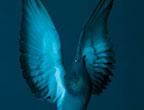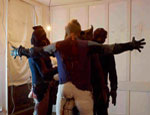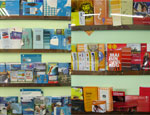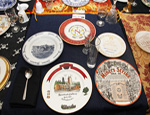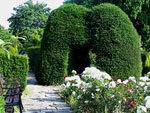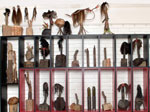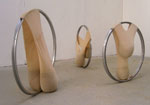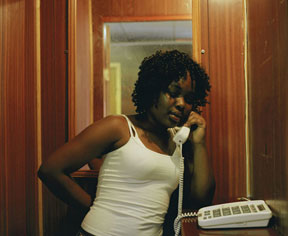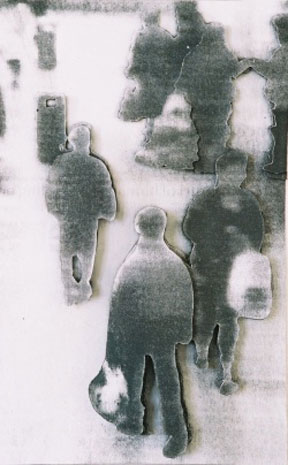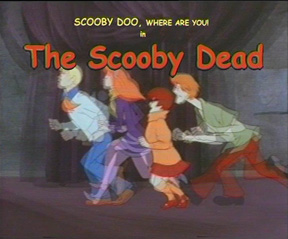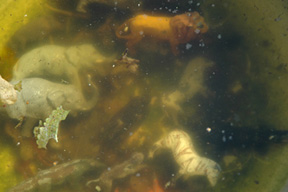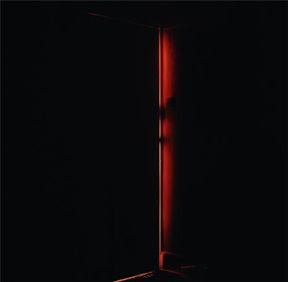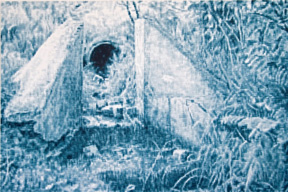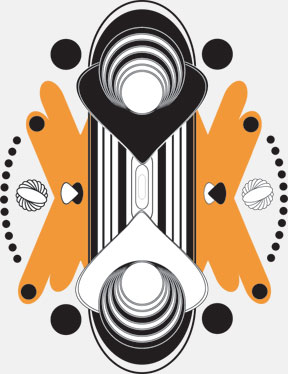CURATING
Terra Incognita
27th Jan - 24th Feb 2007, Angel Row Gallery, Nottingham
Terra Incognita was the first of three shows that formed Parade, an initiative by Nottingham's Angel Row Gallery to showcase the work of artists based in the East Midlands. Each show had a guest curator; Mary Doyle, Leo Fitzmaurice and Indra Khanna.
The artists selected for Terra Incognita were Stephen Connell, Blue Firth, Mik Godley, S Mark Gubb, Anita R Mudaliar, Keith Morris, Lois Wallace and Simon Withers
Terra Incognita
It is a universal human activity to look back in order to discern, or if necessary create, a sense of order from the events of recent or distant history. A narrative is discovered or imposed: we look for links of cause and effect, over-arching patterns which only become clear from a distance, signposts indicating ways of moving into the future.
The artists in this show view this terrain with various degrees of unease, nostalgia or exploratory zeal. They turn to face their own childhood, a family history, a national or cultural history, or a race memory. As the boundaries of our own interior landscapes abut and overlap those of our neighbours, we are able to recognise many of their landmarks – but here have the chance to view them from new vantage points. Terra Incognita – an unknown country. But the lands these artists explore are not entirely unknown to us. We can all recognise their charts.
A second theme that runs through much of this exhibition is the utilisation by artists of images from the mass media – the press, television, family photographs, cinema, story books, the web. Several have sourced 'found' images from the mass media – selecting and manipulating from our vast shared historical stockpile of imagery and visual culture.
Anita Mudaliar
The ghostly figures in Mudaliar’s Conflict and Doubt are derived from generic story-book children's illustrations – being at once humorous, disturbing and bizarre. Who are these characters and what are they striving to tell us? Can you hear their messages from this airless, unchanging world where no-one grows older? Could these trapped children or animals really have anything to say that could possibly be important to us?
| We all know how dark and deep these stories can be– both classic tales such as Peter Pan presented to us by adults, or those we made up ourselves. Through narrative and play we try-out and rehearse the social techniques and strategies we will deploy in our adult lives, a notion emphasised by the fact that it is Mudaliar's own face that is pasted into these drawn scenarios. She is both the creator and the protagonist of these dramas. |
|
Like S Mark Gubb she approaches these stories with humour, after all, they can offer comfort as well as a fright. And a library such as that housing Angel Row Gallery has been a haven and a place of adventure and discovery for many children.
Simon Withers
In Folksongs, Withers re-presents four iconic press photographs. Photographs like these are the illustrations to our contemporary morality or folk tales. Using the domestic hobby technique of decoupage, he has reworked and nullified images, removing the victims, perpetrators and evidence of violence.
The Omagh car-bombing (1998) killed 29 and injured 220. The photo released to the Press originated as a family snapshot taken by a victim and retrieved from the scene by the police. They performed their own decoupage to protect the privacy of the victims' families – all the people were cut out – presenting the viewers with the ghostly white shapes of missing people.
113 died when a Concorde flight from Paris crashed a few minutes after take-off into a hotel (2000). An amateur picture of the plane with its' engine in flames was widely distributed. James Bulger was a toddler abducted by two 10 year olds from the Livingston Shopping Centre, Kirkby and murdered (1993). CCTV camera footage showed him being led away by the two. An image from 9/11 (2001) has been reversed – so that the victim appears to be flying upwards to freedom, rather than falling to his death. Catastrophes have been corrected and the wrongs put right: Jamie was never led out of the shopping centre, planes do not fall from the sky. These things never happened, will never happen to us. We are safe in our towns and cities. |
|
Lois Wallace
JMW Turner (1775-1851) is evoked in the dreamy swathes of light. Wallace revels in pushing the boundaries of landscape painting to the edge of romantic cliché and irony.
| A day trip with her children to visit Santa in Lapland is rendered with the evocative pink tinge and slippery surface of the faded family photos which inform the paintings. The narrative is of a sleigh ride through the icy forest to Santa's cottage, and the warmth inside. She is able to evoke for us the joyful feelings of a childhood Christmas remembered, or a nostalgic, invented Christmas that we wished for but never had. |
|
A more recent series of paintings show a caravan with an interior light on, glimpsed in a dark country field. The sinister atmosphere reminds us of horror films or the witches' cottage in the woods. Like Stephen Connell and Atkinson Grimshaw (1836-1893), she has explored the glowing artificial lights of our streets and playing fields.
S Mark Gubb
Gubb’s draws on popular culture for his work, and he was struck by how closely the plot of the seminal video nasty The Evil Dead mirrored the standard plot of an episode of Scooby Doo. This inspired him to edit the soundtrack of one, to the visuals of the other.
| In a plot easily recognisable from Blue Beard, Little Red Riding Hood or Hansel and Gretel, a group of young people are punished for curiosity, for being sexually active and for disobeying their elders. They stray from the path. Ignoring warnings they visit the cellar of a house in the woods, in which they discover a book of spells and are punished by horrible death at the hands of the zombies and demons that the book conjures up. |
|
The outlawing of The Evil Dead as a video nasty assured its place in British film history and prolonged its shelf life for up-and-coming audiences as it became forbidden fruit. By watching the video, you were yourself disobedient and deserving of punishment.
In creating The Scooby Dead, Gubb is merely following in the footsteps of Disney's Snow White or Sleeping Beauty, sugar-coating a dark story with bright colours.
Keith Morris
A garden is a symbol of the world, and the residents of the garden created by Morris for his photographs live their lives under his direction. But all is not beautiful in this paradise. The white china boundary of this garden reminds us of the white bowl of our own skulls, and the archetypal creatures struggle to survive under the subconscious influence of their creator. Reverting to childhood practice, Morris uses toys to explore the dance of life and death. |
|
He gives us the opportunity to reflect on our own internal space - the primordial liquid world within which swim all our fears and desires. He shows the world below, in which life teems and gives birth to itself, and the world reflected on the tense surface of the water – which is sometimes a mirror, sometimes a lens.
These images are a small selection of numerous photos taken of a bowl accidentally left in Morris's garden, which filled with rain and started to grow algae.
He arranges characters and props to create primal narratives of predator and prey. He both manipulates and exploits the elements – ice, water, beasts, illustrations ripped from books, debris, clouds, sun, frost.
He reflects on the symbolic relationship between objects. His pictures can look like galaxies, planets and zodiacs. He aims to show us both the Microcosm and macrocosm.
Stephen Connell
"Night, sleep, death, and the stars" are the themes a poet's soul loves best, Walt Whitman writes in his poem A Clear Midnight.
Connell’s series Insomnia captures a state of mind we have all experienced. Many artists have said that sleep deprivation can remove the veils between sleep and waking, dream and reality. Kafka, for example, believed his insomnia was a direct source of his creativity, and Nabokov thought sleep was "the most moronic fraternity in the world." For others the forced reflection and introspection often prove unsettling.
The light pollution and noise in an unfamiliar house set Stephen Connell’s mind racing and made sleep impossible. Yet after photographing this particular house through the course of a night, he felt able to sleep there more easily. This is a transient time between sleep and wakefulness, when shadows and patterns of light play tricks on the mind. The two red lights on a plug socket become two red eyes from a half-recalled childhood monster – we cannot possibly sleep until we get up out of bed and cover them. |
|
Like Wallace, he has captured images of street lamps and stadium lights. But is not their beauty that attracts him so much as the fear that they are polluting the sky, blotting out night, sleep and the stars.
Mik Godley
Godley has been investigating his family history. Like many of us, his investigations have not been carried out by physically travelling to a place, but via the internet: information reduced, pixellated and then re-imagined by Godley with additional information from his mother into an imagined homeland. But he has not concentrated exclusively on his own bloodline; instead he has turned his attention to the area surrounding one branch of his family, in once German, now Polish Silesia. Here he discovered landscapes that he could use as illuminating symbols of all of our hidden family histories.
| The internet glimpses of pastoral Silesian forests and mountains seem straight from a Brothers Grimm tale of sleeping giants and treasure-hoarding trolls. But in fact, the undergrowth hides the largest bunker and German headquarters of World War Two, constructed by slave labour, and the internet describes the desperate battles and sieges of the local towns. |
|
A painting of the entrance to one bunker reminds us of Alice's rabbit hole to Wonderland (and it is rumoured that Nazi scientists were developing flying saucers in underground labs). A painting which seems to show a wooded hillside eventually resolves into figure of a sleeping giant, but is in truth derived from a photo of a dead WW II soldier.
Blue Firth
Impossible Possibilities is inspired by the book The Morning of Magicians by Bergier and Pauwell (1960). The book describes a multitude of outlandish theories and conspiracies about the past and present; our ancestors were aliens; Jesus survived the crucifixion, married and had children; the Nazi High Command were all Satanists, etc. It also inspired many other films and books, including Erich Von Daniken's 'The Chariots of the Gods?' (1968), which proposed that the gods of our ancestors and builders of many ancient artefacts were aliens (ideas backed up poor scholarship and misleading illustrations).
Firth harks back to the 1960s and 70s and this first flowering of popular interest in the convergence of mysticism and science. Whether or not we believe in any of Von Daniken's ideas, the book gave many of us as teenagers permission to question the ‘authorised’ version of history (and torment our R.E. teachers). Impossible Possibilities creates a zone which acts as a porthole or stargate, offering an escape route that will take you as far as you are willing to believe. Click the heels of your red shoes together, or ask Scottie to beam you up. Step up and open your mind. © Indra Khanna 2007 |
|
Review of Terra Incognita by Matt Price
Click here to download a PDF of the above curator's introduction to the exhibition Terra Incognita from the catalogue Parade, published by Angel Row Gallery, Nottingham (2007, 1900 words).
Anita R Mudaliar
Lois Wallace
